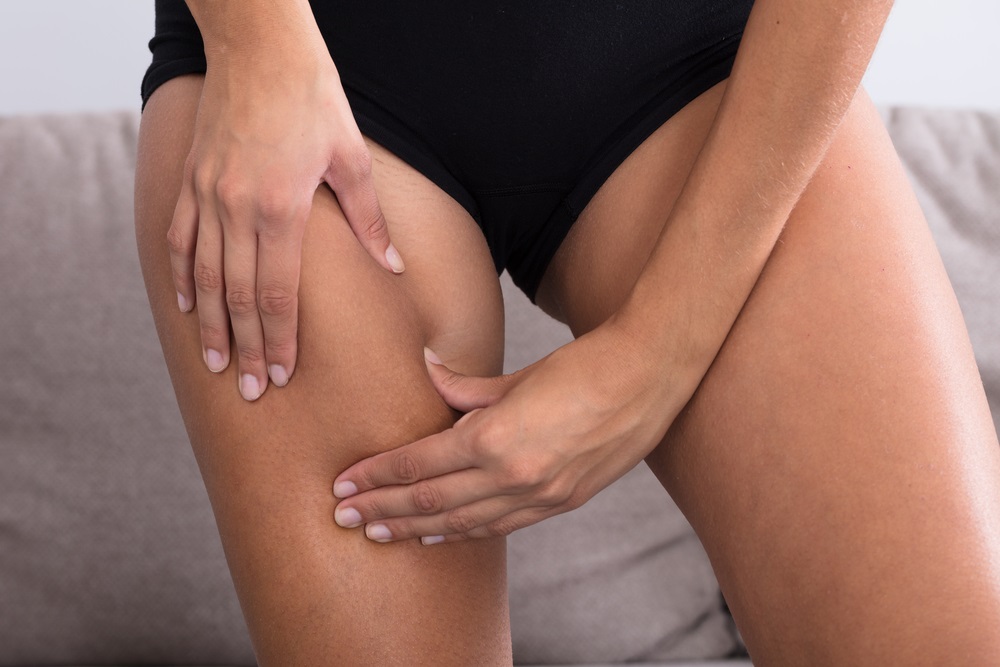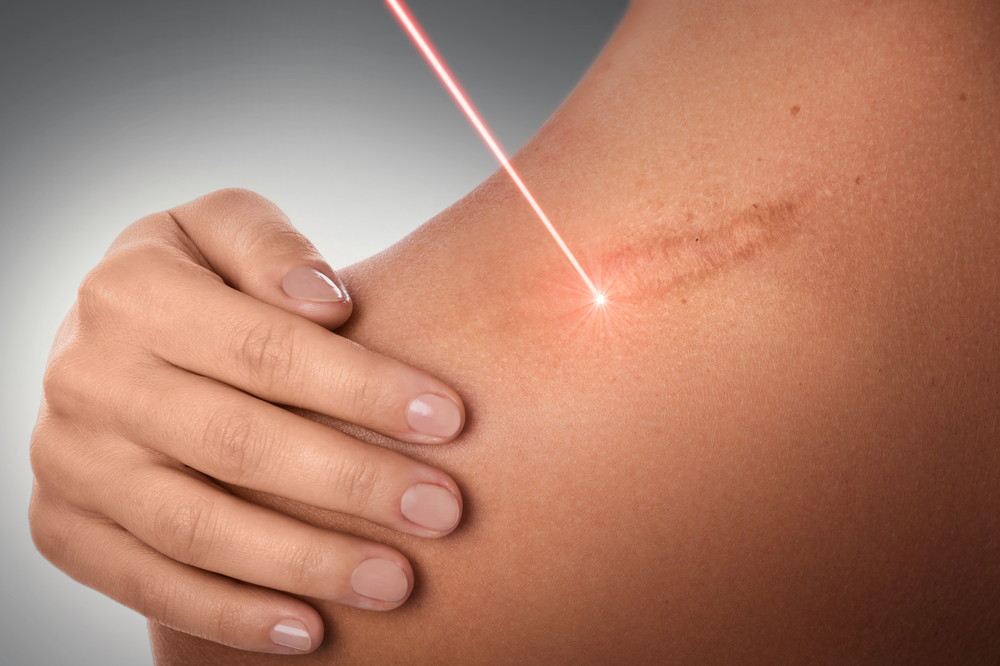- Cellfina is the only FDA approved non-surgical treatment for cellulite.
- Improvements can be seen after 8-12 weeks, and results typically last over a year.
- The cost of the procedure ranges from $3,000-$6,000 USD.
Slimming oils, smoothing creams, body wraps and at-home massaging devices generate massive revenues. Yet, the sad fact is that none of these interventions has been proven to truly banish cellulite. Enter Cellfina.
According to clinical studies and patient testimonials, this minimally invasive, in-office medical treatment reduces the appearance of lumpy skin for up to three years after one single treatment. But despite the positive feedback, it’s important to note that the procedure is not without its drawbacks.
The Ideal Patient Profile
Cellulite occurs when fibrous bands that connect the skin to the underlying muscle tighten irregularly, which then pushes fat deposits upward, creating a lumpy appearance. Cellfina works by releasing these fibrous bands.
Having discrete depressions on the thighs and buttocks, coupled with general good health and a Body Mass Index of 18-35 (i.e. within a 10-pound deviation from your ‘ideal’ weight) makes you a prime candidate for this two-step process.
During the treatment, cellulite dimples are placed under a vacuum-like device. This action sucks and stretches out the fibrous cords. The surgeon then uses a microblade to cut the bands of connective tissue as 6 to 8 cc’s of an anesthetic solution (Lidocaine) is simultaneously administered to the treated area.
Although typically painless, some mild pain has been reported during the medical procedure.
It should be noted that Cellfina has no effect on fat or volume, as it doesn’t reduce the size of the fat pockets in a targeted area. The treatment isn’t approved for the front of the thighs, but it can be used in the buttocks area or on the back of the thighs to treat approximately 25 dents in one single session.
Is It Worth It?
Cellfina costs between $3,000-$6,000. According to studies, patient satisfaction rates are as high as 96% two years post-procedure.
Subcision was first introduced in 1995 and is specifically recommended for cellulite depressions present at rest (versus depressions visible with muscle contraction). Various laser-assisted, manual, and vacuum-assisted subcision treatments have hit the market in recent years.
According to clinical studies, vacuum-assisted subcision treamtents such as Cellfina vastly improve the appearance of cosmetically distressed skin. Results last for 12 months or more, and sometimes as long as three years. Exceptionally, some doctors have noted satisfactory results for up to four years in certain patients.
These results typically take 2-3 months to show. There’s no need for extensive surgery, and only local anesthetic is required. Most patients can go back to work the next day, claims Cellfina maker Merz Aesthetics. For optimal results, treatments are often coupled with Thermage or Ultherapy for skin tightening, injectables to smooth out the treated area, fat transfer, or CoolSculpting.
Toronto-based plastic surgeon Dr. Marc DuPéré from Visage Clinic agrees that subcision is highly efficient, but wonders if the same results could be achieved without the patented and pricey two-step approach.
According to Dr. DuPéré, surgeons and some dermatologists have been performing traditional subcision for many years using special blades that can be sterilized and reused, thus reducing the cost to patients. He does not currently offer Cellfina at his clinic as he finds that “larger, deeper ‘lakes’ of cellulite respond better to traditional subcision techniques.”
However, Dr. Dupéré does concede that Cellfina’s standard, piston-driven 18-gauge blade might be useful for physicians who are less surgically-oriented or technically inclined. “Cellfina might be time-efficient for one or two adjacent cellulitic lesions,” he says. “It is a cool concept and a ‘tool’ which will be more easily marketable than traditional subcision.”
Ultimately, Dr. Dupéré believes that Cellfina offers similar results to those that can be expected from traditional subcision. However, he feels that vacuum-assisted subcision is more time-consuming, and notes that traditional subcision can be used to treat even severe cellulite as the blades come in many sizes.
Cellfina Recovery and Results
Aside from the steep price – that rises when coupled with other treatments – there are other caveats associated with the Cellfina procedure that should be taken into consideration. Although it is highly efficient at reducing the appearance of cellulite, patients shouldn’t expect an overnight transformation.
If you are constantly on the move, some serious downtime should be penciled in ahead of time, as bruising and tenderness will persist for the first few weeks. That means it may prove unwise to book a beach holiday or undergo this treatment right before summertime when the weather calls for shorter hems.
Although unsightly, bruising and swelling are crucial in the process of wound healing. According to Dr. DuPéré, “the creation of a bruise with subcision is important for the remodelling and filling of the just-created mini dead spaces once the fibrous septa are severed.”
For this very reason, many doctors suggest that patients wear compression garments for 2 to 4 weeks after the procedure.
Some patients also report scarring at the point of incision and persistent skin discoloration – even though the puncture site is the size of a needle.
To encourage proper healing, smoking and alcohol consumption are strongly discouraged for several days pre-and post-treatment. Extreme physical activity should be avoided within the first 30-days post-treatment as an elevated core temperature can cause more swelling. Only light exercise is allowed.
Post-procedural care shouldn’t be overlooked as side effects can also include:
- Leakage from the incisions.
- Soreness that persists for a few weeks.
- Swelling that can last up to 2 months.
Since patients may experience leakage from the incision sites, they are advised to protect their mattresses and any other upholstered furniture. Baths are also banned until all incision sites are closed.
Some patients report having to wear dark pants in order to cover the deep bruises and bleeding, and having to use towels in bed to protect the bedding.
This healing process and fluid accumulation within the treatment region are entirely normal occurrences. Cellfina’s post-treatment instructions may prove to be relatively constraining and will warrant a few temporary lifestyle adjustments. However, over time, the treated tissue will heal and become firmer.

The Bottom Line
Despite the downtime required, the buzz is not all bad. Dr. Sheila Nazarian, founder of Nazarian Plastic Surgery in Beverly Hills, has performed over fifty Cellfina procedures thus far. She notes that the biggest hurdle for the Cellfina procedure is patient awareness and education.
“So many products and procedures out there promise to deliver results and don’t,” says Dr. Nazarian. “Women are understandably skeptical. It is our job as physicians and influencers to get the word out.”
The plastic surgeon acknowledges that bruising, small scars and pock marks are possible complications but remarks that “it’s the only cellulite treatment that works. Everything else is only temporary.”









